Report: Training and Development Environment at Medtronic, Australia
VerifiedAdded on 2021/04/21
|11
|2506
|157
Report
AI Summary
This report provides an executive summary and in-depth analysis of the training and development environment at Medtronic Australia. It discusses the impact of high-performance work systems (HPWS) on employee attitudes, behaviors, and group performance. The report focuses on two key models, ISD and ADDIE, used to design effective training sessions, create a good learning environment, and ensure the proper transfer of training methods. It also explores how HPWS models facilitate needs assessment and promote a diversified workforce. The report highlights the importance of managerial skills, including leadership, communication, critical thinking, and project management, to achieve organizational goals. Finally, the report emphasizes the alignment of HR practices with organizational strategies to enhance employee skills, knowledge, and motivation. The report concludes with a discussion of the key skills needed by managers and leaders at Medtronic to drive success.
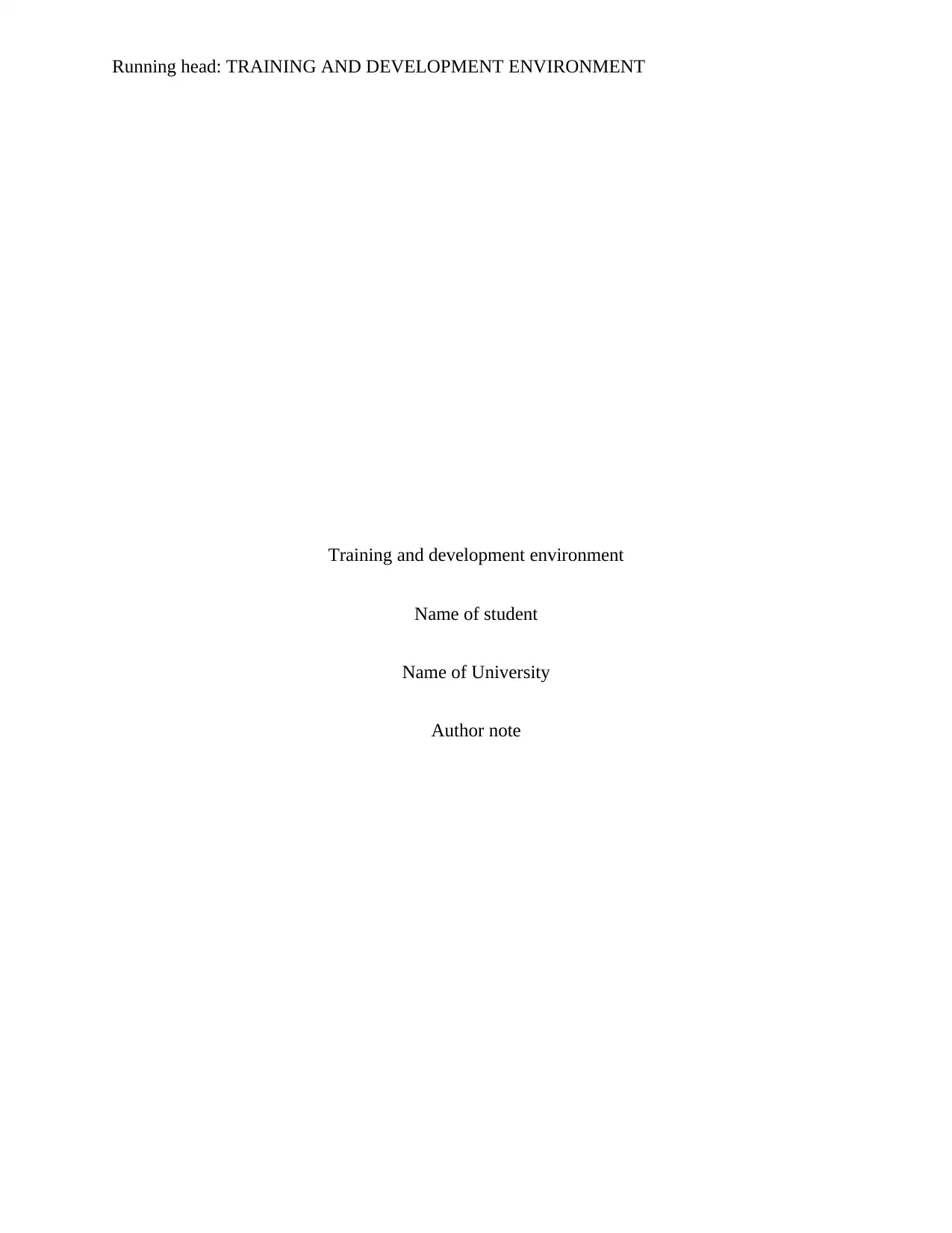
Running head: TRAINING AND DEVELOPMENT ENVIRONMENT
Training and development environment
Name of student
Name of University
Author note
Training and development environment
Name of student
Name of University
Author note
Paraphrase This Document
Need a fresh take? Get an instant paraphrase of this document with our AI Paraphraser
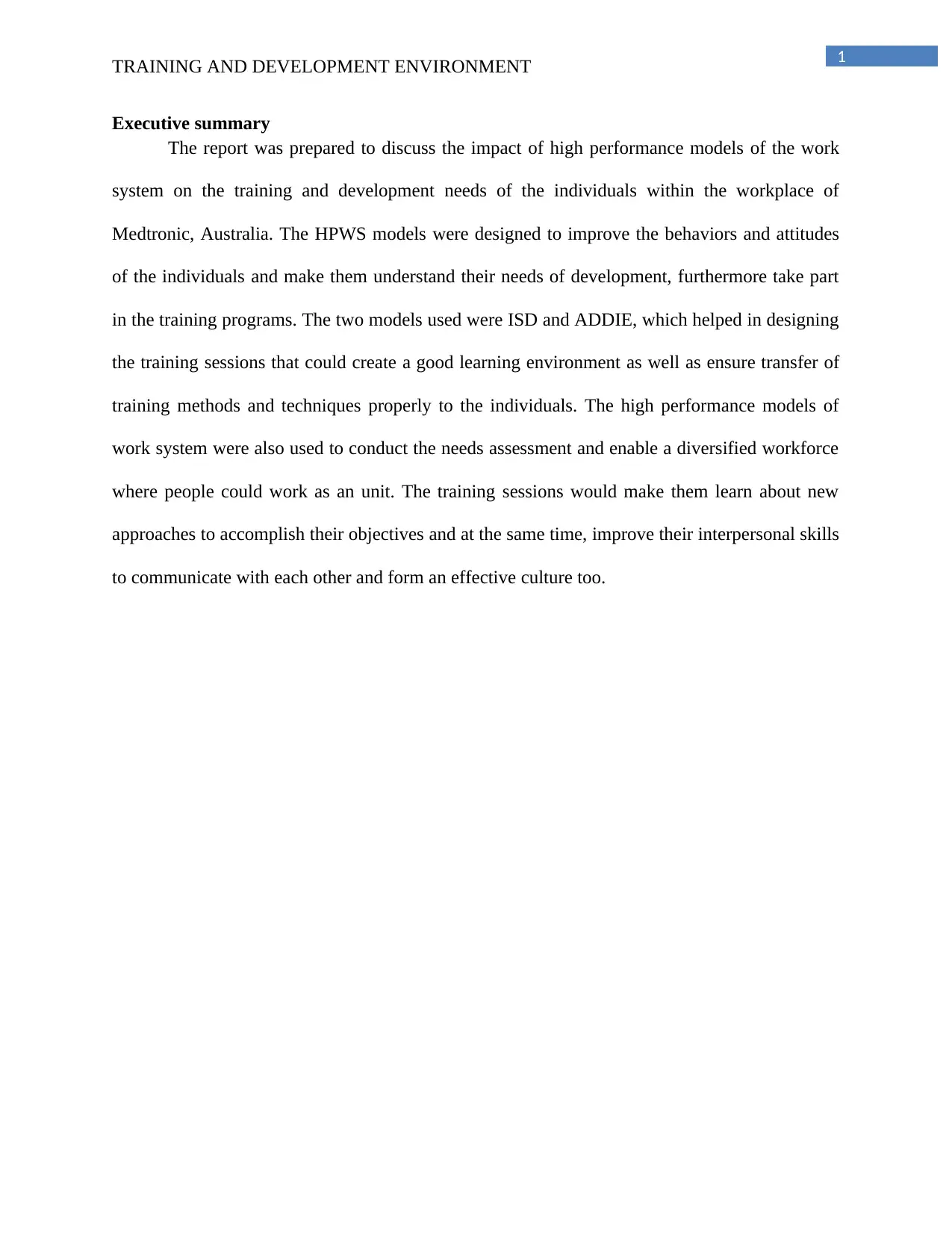
1
TRAINING AND DEVELOPMENT ENVIRONMENT
Executive summary
The report was prepared to discuss the impact of high performance models of the work
system on the training and development needs of the individuals within the workplace of
Medtronic, Australia. The HPWS models were designed to improve the behaviors and attitudes
of the individuals and make them understand their needs of development, furthermore take part
in the training programs. The two models used were ISD and ADDIE, which helped in designing
the training sessions that could create a good learning environment as well as ensure transfer of
training methods and techniques properly to the individuals. The high performance models of
work system were also used to conduct the needs assessment and enable a diversified workforce
where people could work as an unit. The training sessions would make them learn about new
approaches to accomplish their objectives and at the same time, improve their interpersonal skills
to communicate with each other and form an effective culture too.
TRAINING AND DEVELOPMENT ENVIRONMENT
Executive summary
The report was prepared to discuss the impact of high performance models of the work
system on the training and development needs of the individuals within the workplace of
Medtronic, Australia. The HPWS models were designed to improve the behaviors and attitudes
of the individuals and make them understand their needs of development, furthermore take part
in the training programs. The two models used were ISD and ADDIE, which helped in designing
the training sessions that could create a good learning environment as well as ensure transfer of
training methods and techniques properly to the individuals. The high performance models of
work system were also used to conduct the needs assessment and enable a diversified workforce
where people could work as an unit. The training sessions would make them learn about new
approaches to accomplish their objectives and at the same time, improve their interpersonal skills
to communicate with each other and form an effective culture too.
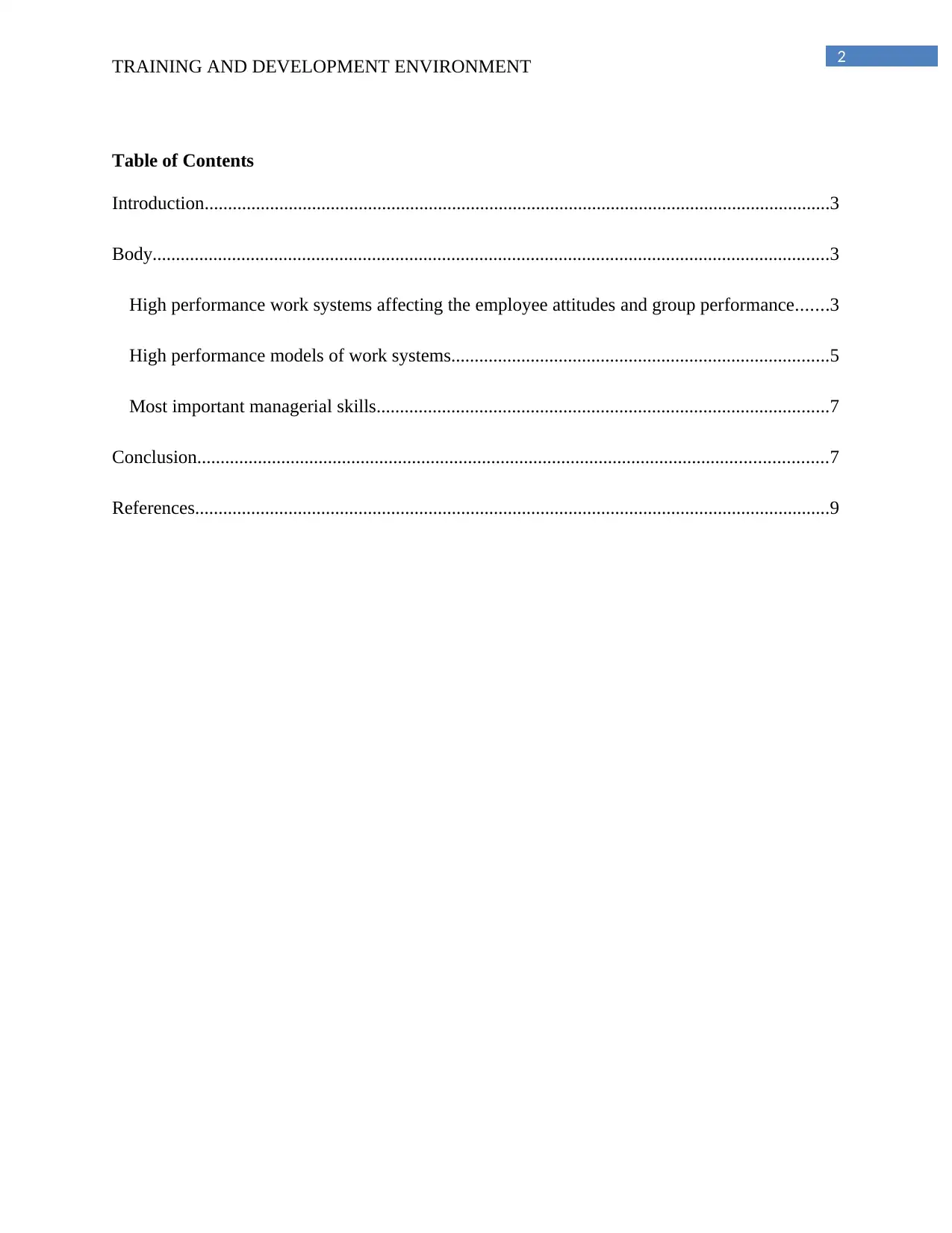
2
TRAINING AND DEVELOPMENT ENVIRONMENT
Table of Contents
Introduction......................................................................................................................................3
Body.................................................................................................................................................3
High performance work systems affecting the employee attitudes and group performance.......3
High performance models of work systems.................................................................................5
Most important managerial skills.................................................................................................7
Conclusion.......................................................................................................................................7
References........................................................................................................................................9
TRAINING AND DEVELOPMENT ENVIRONMENT
Table of Contents
Introduction......................................................................................................................................3
Body.................................................................................................................................................3
High performance work systems affecting the employee attitudes and group performance.......3
High performance models of work systems.................................................................................5
Most important managerial skills.................................................................................................7
Conclusion.......................................................................................................................................7
References........................................................................................................................................9
⊘ This is a preview!⊘
Do you want full access?
Subscribe today to unlock all pages.

Trusted by 1+ million students worldwide
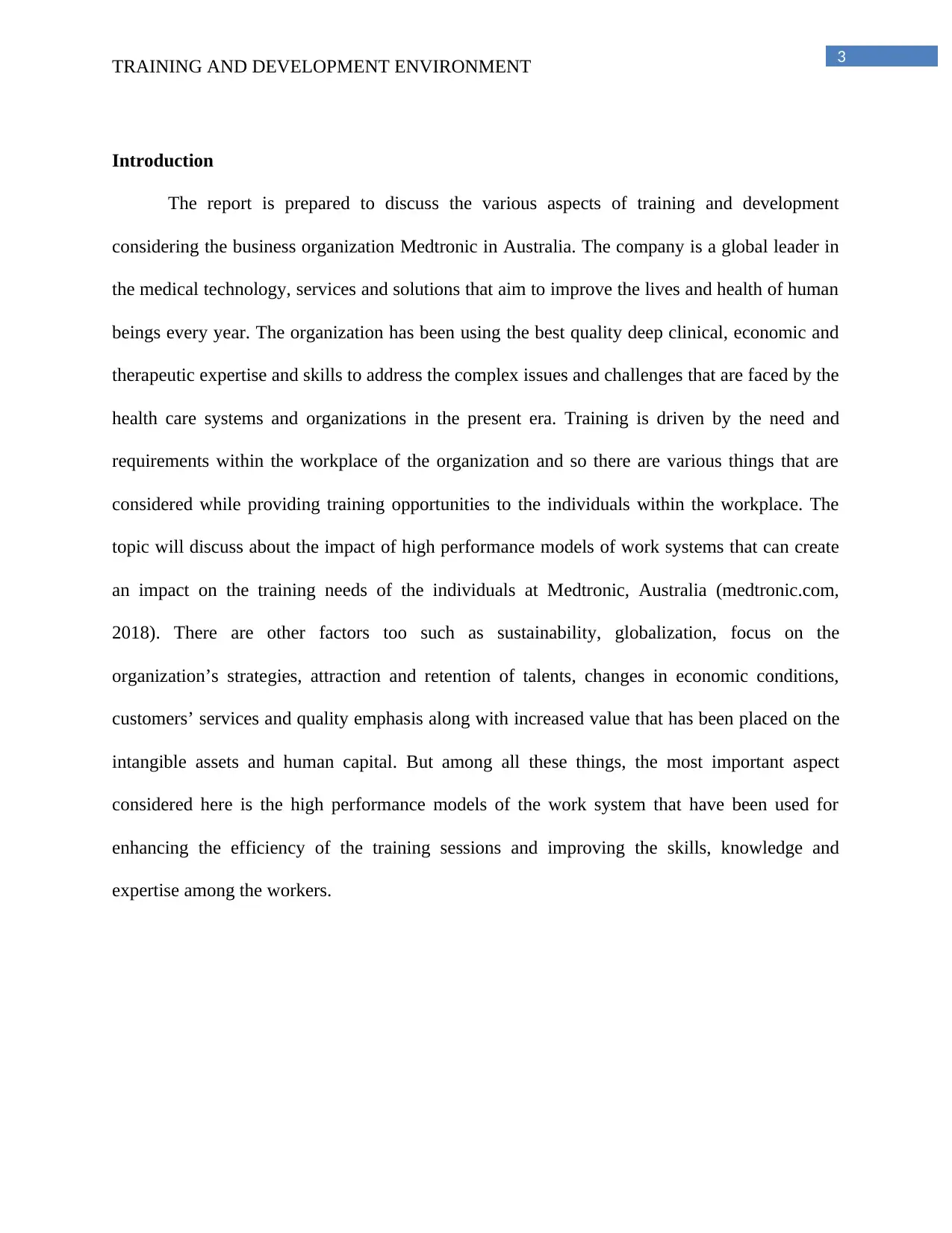
3
TRAINING AND DEVELOPMENT ENVIRONMENT
Introduction
The report is prepared to discuss the various aspects of training and development
considering the business organization Medtronic in Australia. The company is a global leader in
the medical technology, services and solutions that aim to improve the lives and health of human
beings every year. The organization has been using the best quality deep clinical, economic and
therapeutic expertise and skills to address the complex issues and challenges that are faced by the
health care systems and organizations in the present era. Training is driven by the need and
requirements within the workplace of the organization and so there are various things that are
considered while providing training opportunities to the individuals within the workplace. The
topic will discuss about the impact of high performance models of work systems that can create
an impact on the training needs of the individuals at Medtronic, Australia (medtronic.com,
2018). There are other factors too such as sustainability, globalization, focus on the
organization’s strategies, attraction and retention of talents, changes in economic conditions,
customers’ services and quality emphasis along with increased value that has been placed on the
intangible assets and human capital. But among all these things, the most important aspect
considered here is the high performance models of the work system that have been used for
enhancing the efficiency of the training sessions and improving the skills, knowledge and
expertise among the workers.
TRAINING AND DEVELOPMENT ENVIRONMENT
Introduction
The report is prepared to discuss the various aspects of training and development
considering the business organization Medtronic in Australia. The company is a global leader in
the medical technology, services and solutions that aim to improve the lives and health of human
beings every year. The organization has been using the best quality deep clinical, economic and
therapeutic expertise and skills to address the complex issues and challenges that are faced by the
health care systems and organizations in the present era. Training is driven by the need and
requirements within the workplace of the organization and so there are various things that are
considered while providing training opportunities to the individuals within the workplace. The
topic will discuss about the impact of high performance models of work systems that can create
an impact on the training needs of the individuals at Medtronic, Australia (medtronic.com,
2018). There are other factors too such as sustainability, globalization, focus on the
organization’s strategies, attraction and retention of talents, changes in economic conditions,
customers’ services and quality emphasis along with increased value that has been placed on the
intangible assets and human capital. But among all these things, the most important aspect
considered here is the high performance models of the work system that have been used for
enhancing the efficiency of the training sessions and improving the skills, knowledge and
expertise among the workers.
Paraphrase This Document
Need a fresh take? Get an instant paraphrase of this document with our AI Paraphraser
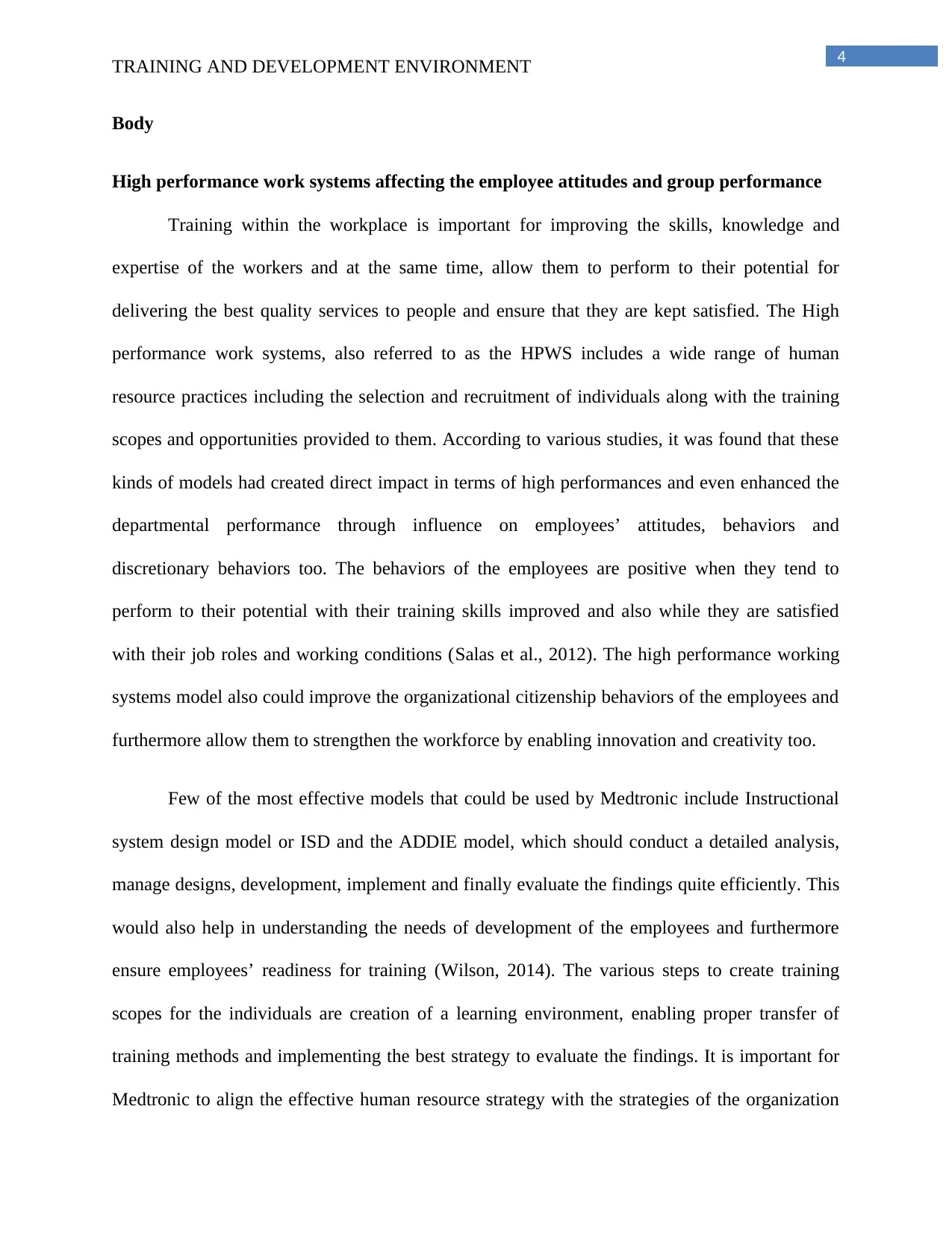
4
TRAINING AND DEVELOPMENT ENVIRONMENT
Body
High performance work systems affecting the employee attitudes and group performance
Training within the workplace is important for improving the skills, knowledge and
expertise of the workers and at the same time, allow them to perform to their potential for
delivering the best quality services to people and ensure that they are kept satisfied. The High
performance work systems, also referred to as the HPWS includes a wide range of human
resource practices including the selection and recruitment of individuals along with the training
scopes and opportunities provided to them. According to various studies, it was found that these
kinds of models had created direct impact in terms of high performances and even enhanced the
departmental performance through influence on employees’ attitudes, behaviors and
discretionary behaviors too. The behaviors of the employees are positive when they tend to
perform to their potential with their training skills improved and also while they are satisfied
with their job roles and working conditions (Salas et al., 2012). The high performance working
systems model also could improve the organizational citizenship behaviors of the employees and
furthermore allow them to strengthen the workforce by enabling innovation and creativity too.
Few of the most effective models that could be used by Medtronic include Instructional
system design model or ISD and the ADDIE model, which should conduct a detailed analysis,
manage designs, development, implement and finally evaluate the findings quite efficiently. This
would also help in understanding the needs of development of the employees and furthermore
ensure employees’ readiness for training (Wilson, 2014). The various steps to create training
scopes for the individuals are creation of a learning environment, enabling proper transfer of
training methods and implementing the best strategy to evaluate the findings. It is important for
Medtronic to align the effective human resource strategy with the strategies of the organization
TRAINING AND DEVELOPMENT ENVIRONMENT
Body
High performance work systems affecting the employee attitudes and group performance
Training within the workplace is important for improving the skills, knowledge and
expertise of the workers and at the same time, allow them to perform to their potential for
delivering the best quality services to people and ensure that they are kept satisfied. The High
performance work systems, also referred to as the HPWS includes a wide range of human
resource practices including the selection and recruitment of individuals along with the training
scopes and opportunities provided to them. According to various studies, it was found that these
kinds of models had created direct impact in terms of high performances and even enhanced the
departmental performance through influence on employees’ attitudes, behaviors and
discretionary behaviors too. The behaviors of the employees are positive when they tend to
perform to their potential with their training skills improved and also while they are satisfied
with their job roles and working conditions (Salas et al., 2012). The high performance working
systems model also could improve the organizational citizenship behaviors of the employees and
furthermore allow them to strengthen the workforce by enabling innovation and creativity too.
Few of the most effective models that could be used by Medtronic include Instructional
system design model or ISD and the ADDIE model, which should conduct a detailed analysis,
manage designs, development, implement and finally evaluate the findings quite efficiently. This
would also help in understanding the needs of development of the employees and furthermore
ensure employees’ readiness for training (Wilson, 2014). The various steps to create training
scopes for the individuals are creation of a learning environment, enabling proper transfer of
training methods and implementing the best strategy to evaluate the findings. It is important for
Medtronic to align the effective human resource strategy with the strategies of the organization
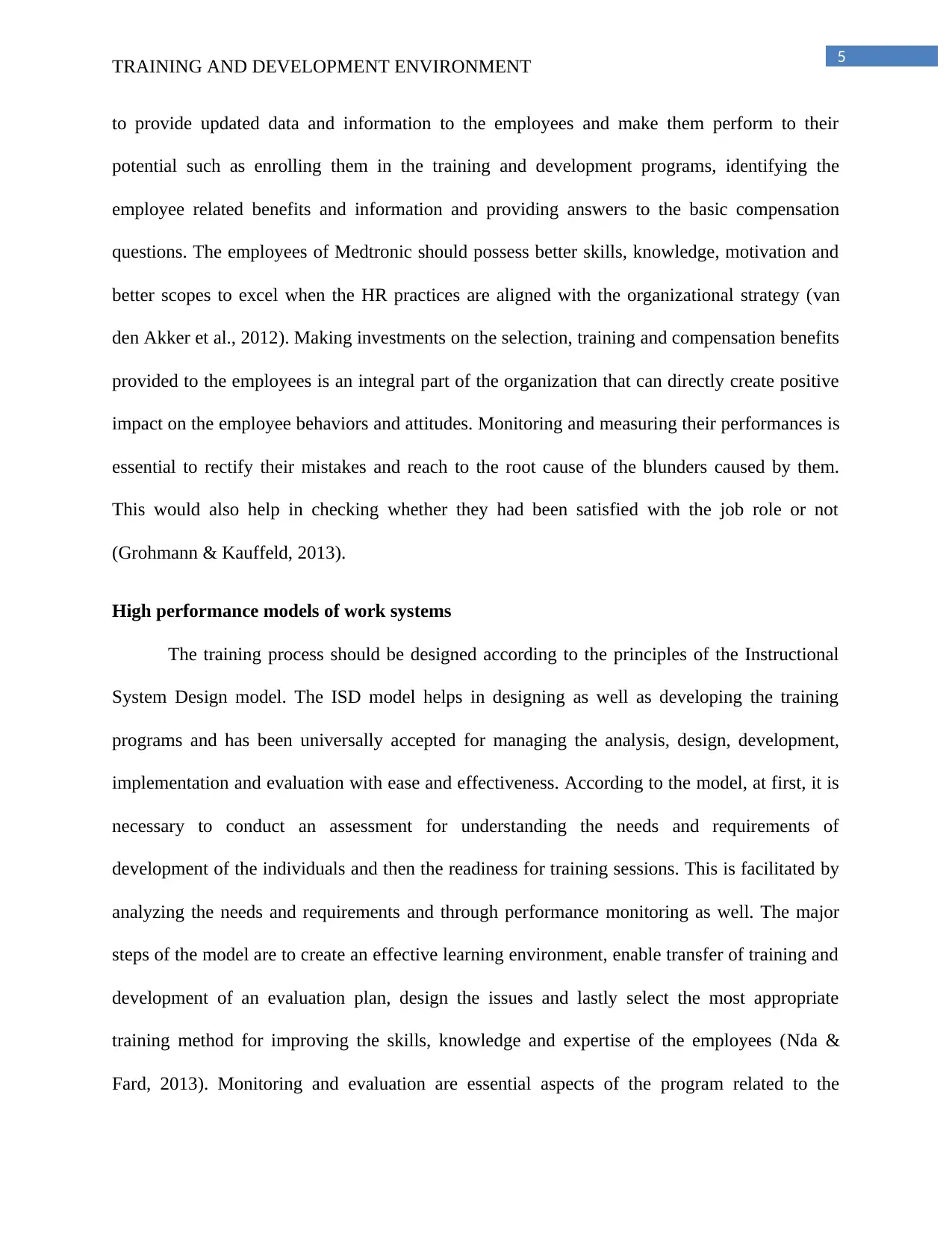
5
TRAINING AND DEVELOPMENT ENVIRONMENT
to provide updated data and information to the employees and make them perform to their
potential such as enrolling them in the training and development programs, identifying the
employee related benefits and information and providing answers to the basic compensation
questions. The employees of Medtronic should possess better skills, knowledge, motivation and
better scopes to excel when the HR practices are aligned with the organizational strategy (van
den Akker et al., 2012). Making investments on the selection, training and compensation benefits
provided to the employees is an integral part of the organization that can directly create positive
impact on the employee behaviors and attitudes. Monitoring and measuring their performances is
essential to rectify their mistakes and reach to the root cause of the blunders caused by them.
This would also help in checking whether they had been satisfied with the job role or not
(Grohmann & Kauffeld, 2013).
High performance models of work systems
The training process should be designed according to the principles of the Instructional
System Design model. The ISD model helps in designing as well as developing the training
programs and has been universally accepted for managing the analysis, design, development,
implementation and evaluation with ease and effectiveness. According to the model, at first, it is
necessary to conduct an assessment for understanding the needs and requirements of
development of the individuals and then the readiness for training sessions. This is facilitated by
analyzing the needs and requirements and through performance monitoring as well. The major
steps of the model are to create an effective learning environment, enable transfer of training and
development of an evaluation plan, design the issues and lastly select the most appropriate
training method for improving the skills, knowledge and expertise of the employees (Nda &
Fard, 2013). Monitoring and evaluation are essential aspects of the program related to the
TRAINING AND DEVELOPMENT ENVIRONMENT
to provide updated data and information to the employees and make them perform to their
potential such as enrolling them in the training and development programs, identifying the
employee related benefits and information and providing answers to the basic compensation
questions. The employees of Medtronic should possess better skills, knowledge, motivation and
better scopes to excel when the HR practices are aligned with the organizational strategy (van
den Akker et al., 2012). Making investments on the selection, training and compensation benefits
provided to the employees is an integral part of the organization that can directly create positive
impact on the employee behaviors and attitudes. Monitoring and measuring their performances is
essential to rectify their mistakes and reach to the root cause of the blunders caused by them.
This would also help in checking whether they had been satisfied with the job role or not
(Grohmann & Kauffeld, 2013).
High performance models of work systems
The training process should be designed according to the principles of the Instructional
System Design model. The ISD model helps in designing as well as developing the training
programs and has been universally accepted for managing the analysis, design, development,
implementation and evaluation with ease and effectiveness. According to the model, at first, it is
necessary to conduct an assessment for understanding the needs and requirements of
development of the individuals and then the readiness for training sessions. This is facilitated by
analyzing the needs and requirements and through performance monitoring as well. The major
steps of the model are to create an effective learning environment, enable transfer of training and
development of an evaluation plan, design the issues and lastly select the most appropriate
training method for improving the skills, knowledge and expertise of the employees (Nda &
Fard, 2013). Monitoring and evaluation are essential aspects of the program related to the
⊘ This is a preview!⊘
Do you want full access?
Subscribe today to unlock all pages.

Trusted by 1+ million students worldwide
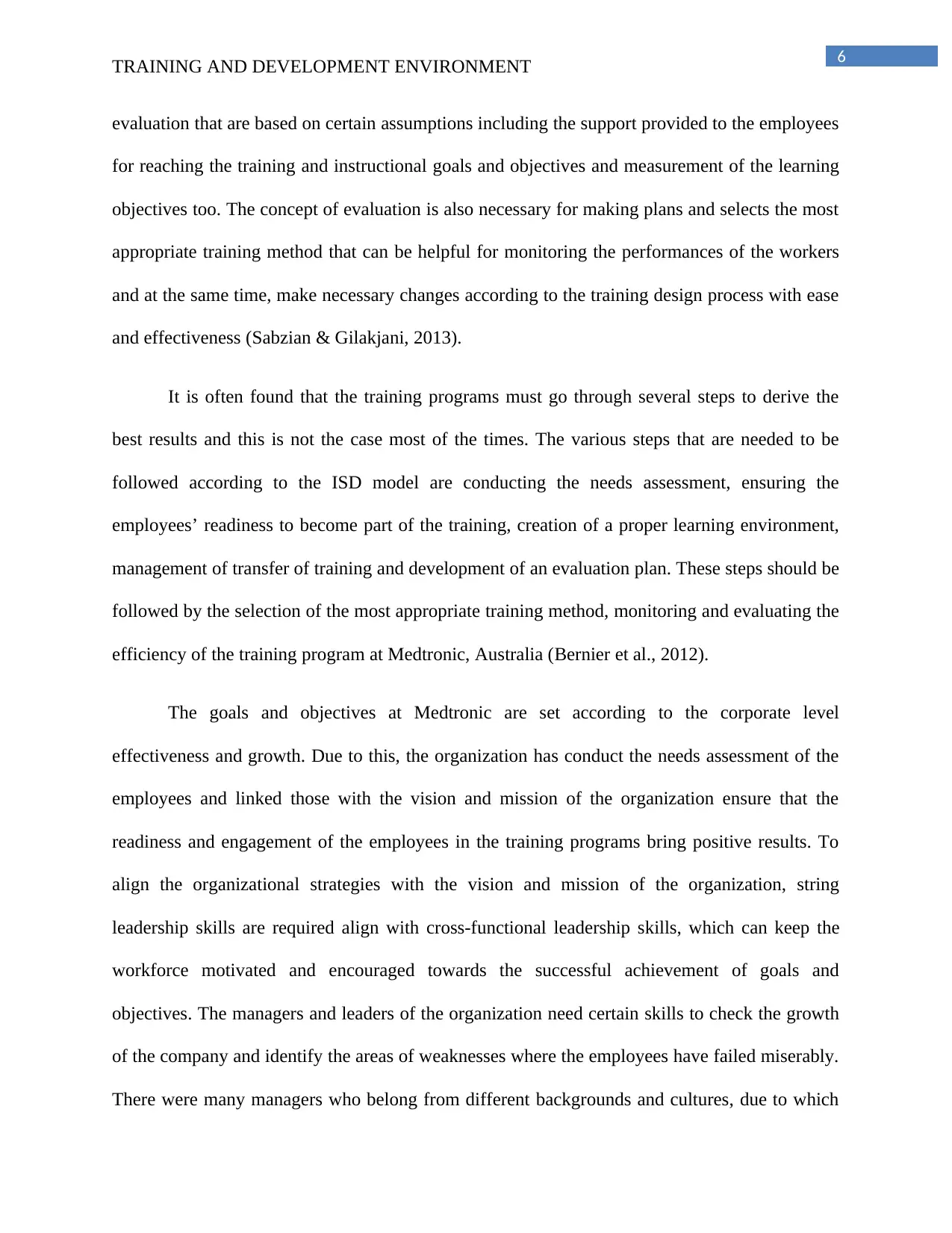
6
TRAINING AND DEVELOPMENT ENVIRONMENT
evaluation that are based on certain assumptions including the support provided to the employees
for reaching the training and instructional goals and objectives and measurement of the learning
objectives too. The concept of evaluation is also necessary for making plans and selects the most
appropriate training method that can be helpful for monitoring the performances of the workers
and at the same time, make necessary changes according to the training design process with ease
and effectiveness (Sabzian & Gilakjani, 2013).
It is often found that the training programs must go through several steps to derive the
best results and this is not the case most of the times. The various steps that are needed to be
followed according to the ISD model are conducting the needs assessment, ensuring the
employees’ readiness to become part of the training, creation of a proper learning environment,
management of transfer of training and development of an evaluation plan. These steps should be
followed by the selection of the most appropriate training method, monitoring and evaluating the
efficiency of the training program at Medtronic, Australia (Bernier et al., 2012).
The goals and objectives at Medtronic are set according to the corporate level
effectiveness and growth. Due to this, the organization has conduct the needs assessment of the
employees and linked those with the vision and mission of the organization ensure that the
readiness and engagement of the employees in the training programs bring positive results. To
align the organizational strategies with the vision and mission of the organization, string
leadership skills are required align with cross-functional leadership skills, which can keep the
workforce motivated and encouraged towards the successful achievement of goals and
objectives. The managers and leaders of the organization need certain skills to check the growth
of the company and identify the areas of weaknesses where the employees have failed miserably.
There were many managers who belong from different backgrounds and cultures, due to which
TRAINING AND DEVELOPMENT ENVIRONMENT
evaluation that are based on certain assumptions including the support provided to the employees
for reaching the training and instructional goals and objectives and measurement of the learning
objectives too. The concept of evaluation is also necessary for making plans and selects the most
appropriate training method that can be helpful for monitoring the performances of the workers
and at the same time, make necessary changes according to the training design process with ease
and effectiveness (Sabzian & Gilakjani, 2013).
It is often found that the training programs must go through several steps to derive the
best results and this is not the case most of the times. The various steps that are needed to be
followed according to the ISD model are conducting the needs assessment, ensuring the
employees’ readiness to become part of the training, creation of a proper learning environment,
management of transfer of training and development of an evaluation plan. These steps should be
followed by the selection of the most appropriate training method, monitoring and evaluating the
efficiency of the training program at Medtronic, Australia (Bernier et al., 2012).
The goals and objectives at Medtronic are set according to the corporate level
effectiveness and growth. Due to this, the organization has conduct the needs assessment of the
employees and linked those with the vision and mission of the organization ensure that the
readiness and engagement of the employees in the training programs bring positive results. To
align the organizational strategies with the vision and mission of the organization, string
leadership skills are required align with cross-functional leadership skills, which can keep the
workforce motivated and encouraged towards the successful achievement of goals and
objectives. The managers and leaders of the organization need certain skills to check the growth
of the company and identify the areas of weaknesses where the employees have failed miserably.
There were many managers who belong from different backgrounds and cultures, due to which
Paraphrase This Document
Need a fresh take? Get an instant paraphrase of this document with our AI Paraphraser
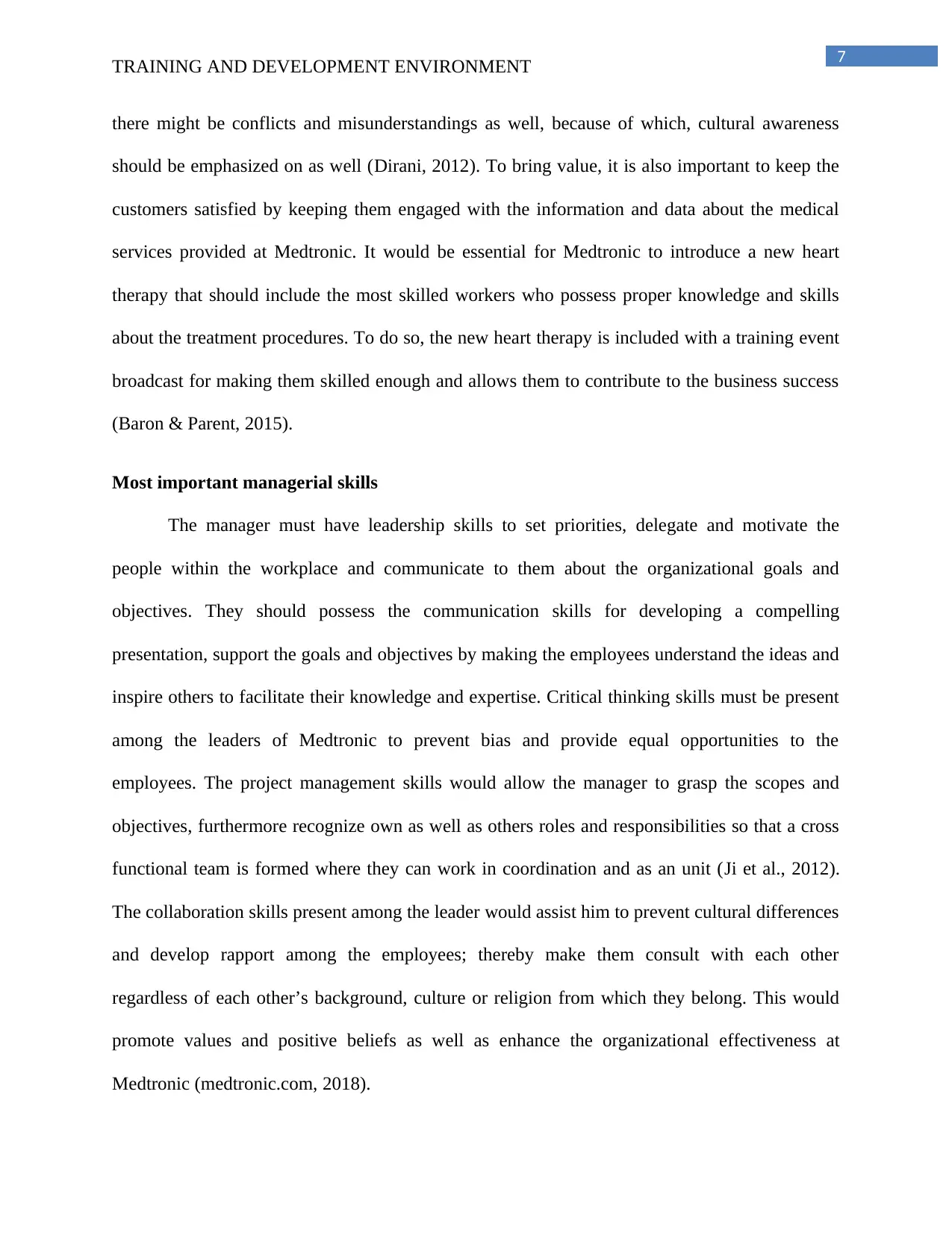
7
TRAINING AND DEVELOPMENT ENVIRONMENT
there might be conflicts and misunderstandings as well, because of which, cultural awareness
should be emphasized on as well (Dirani, 2012). To bring value, it is also important to keep the
customers satisfied by keeping them engaged with the information and data about the medical
services provided at Medtronic. It would be essential for Medtronic to introduce a new heart
therapy that should include the most skilled workers who possess proper knowledge and skills
about the treatment procedures. To do so, the new heart therapy is included with a training event
broadcast for making them skilled enough and allows them to contribute to the business success
(Baron & Parent, 2015).
Most important managerial skills
The manager must have leadership skills to set priorities, delegate and motivate the
people within the workplace and communicate to them about the organizational goals and
objectives. They should possess the communication skills for developing a compelling
presentation, support the goals and objectives by making the employees understand the ideas and
inspire others to facilitate their knowledge and expertise. Critical thinking skills must be present
among the leaders of Medtronic to prevent bias and provide equal opportunities to the
employees. The project management skills would allow the manager to grasp the scopes and
objectives, furthermore recognize own as well as others roles and responsibilities so that a cross
functional team is formed where they can work in coordination and as an unit (Ji et al., 2012).
The collaboration skills present among the leader would assist him to prevent cultural differences
and develop rapport among the employees; thereby make them consult with each other
regardless of each other’s background, culture or religion from which they belong. This would
promote values and positive beliefs as well as enhance the organizational effectiveness at
Medtronic (medtronic.com, 2018).
TRAINING AND DEVELOPMENT ENVIRONMENT
there might be conflicts and misunderstandings as well, because of which, cultural awareness
should be emphasized on as well (Dirani, 2012). To bring value, it is also important to keep the
customers satisfied by keeping them engaged with the information and data about the medical
services provided at Medtronic. It would be essential for Medtronic to introduce a new heart
therapy that should include the most skilled workers who possess proper knowledge and skills
about the treatment procedures. To do so, the new heart therapy is included with a training event
broadcast for making them skilled enough and allows them to contribute to the business success
(Baron & Parent, 2015).
Most important managerial skills
The manager must have leadership skills to set priorities, delegate and motivate the
people within the workplace and communicate to them about the organizational goals and
objectives. They should possess the communication skills for developing a compelling
presentation, support the goals and objectives by making the employees understand the ideas and
inspire others to facilitate their knowledge and expertise. Critical thinking skills must be present
among the leaders of Medtronic to prevent bias and provide equal opportunities to the
employees. The project management skills would allow the manager to grasp the scopes and
objectives, furthermore recognize own as well as others roles and responsibilities so that a cross
functional team is formed where they can work in coordination and as an unit (Ji et al., 2012).
The collaboration skills present among the leader would assist him to prevent cultural differences
and develop rapport among the employees; thereby make them consult with each other
regardless of each other’s background, culture or religion from which they belong. This would
promote values and positive beliefs as well as enhance the organizational effectiveness at
Medtronic (medtronic.com, 2018).
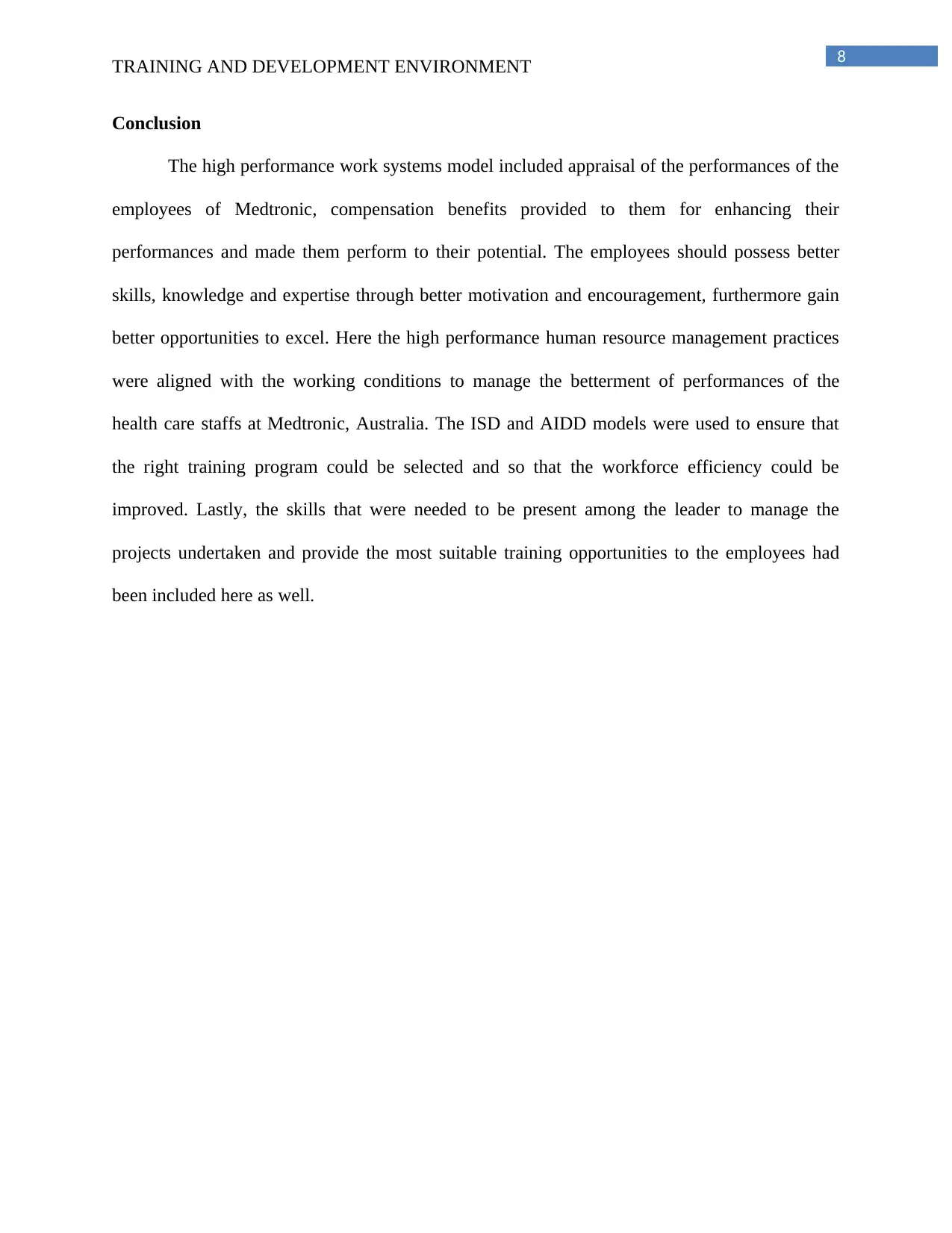
8
TRAINING AND DEVELOPMENT ENVIRONMENT
Conclusion
The high performance work systems model included appraisal of the performances of the
employees of Medtronic, compensation benefits provided to them for enhancing their
performances and made them perform to their potential. The employees should possess better
skills, knowledge and expertise through better motivation and encouragement, furthermore gain
better opportunities to excel. Here the high performance human resource management practices
were aligned with the working conditions to manage the betterment of performances of the
health care staffs at Medtronic, Australia. The ISD and AIDD models were used to ensure that
the right training program could be selected and so that the workforce efficiency could be
improved. Lastly, the skills that were needed to be present among the leader to manage the
projects undertaken and provide the most suitable training opportunities to the employees had
been included here as well.
TRAINING AND DEVELOPMENT ENVIRONMENT
Conclusion
The high performance work systems model included appraisal of the performances of the
employees of Medtronic, compensation benefits provided to them for enhancing their
performances and made them perform to their potential. The employees should possess better
skills, knowledge and expertise through better motivation and encouragement, furthermore gain
better opportunities to excel. Here the high performance human resource management practices
were aligned with the working conditions to manage the betterment of performances of the
health care staffs at Medtronic, Australia. The ISD and AIDD models were used to ensure that
the right training program could be selected and so that the workforce efficiency could be
improved. Lastly, the skills that were needed to be present among the leader to manage the
projects undertaken and provide the most suitable training opportunities to the employees had
been included here as well.
⊘ This is a preview!⊘
Do you want full access?
Subscribe today to unlock all pages.

Trusted by 1+ million students worldwide
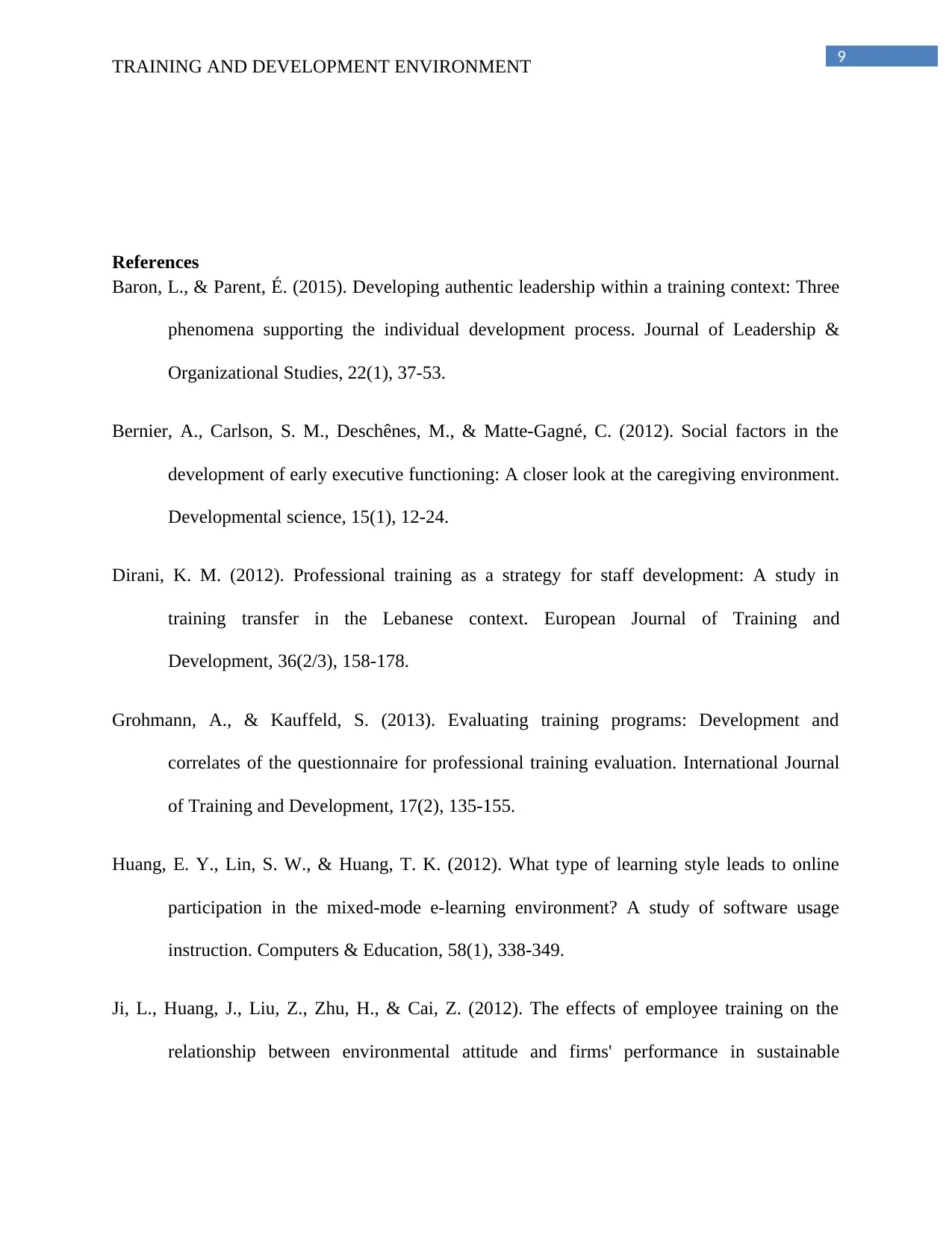
9
TRAINING AND DEVELOPMENT ENVIRONMENT
References
Baron, L., & Parent, É. (2015). Developing authentic leadership within a training context: Three
phenomena supporting the individual development process. Journal of Leadership &
Organizational Studies, 22(1), 37-53.
Bernier, A., Carlson, S. M., Deschênes, M., & Matte‐Gagné, C. (2012). Social factors in the
development of early executive functioning: A closer look at the caregiving environment.
Developmental science, 15(1), 12-24.
Dirani, K. M. (2012). Professional training as a strategy for staff development: A study in
training transfer in the Lebanese context. European Journal of Training and
Development, 36(2/3), 158-178.
Grohmann, A., & Kauffeld, S. (2013). Evaluating training programs: Development and
correlates of the questionnaire for professional training evaluation. International Journal
of Training and Development, 17(2), 135-155.
Huang, E. Y., Lin, S. W., & Huang, T. K. (2012). What type of learning style leads to online
participation in the mixed-mode e-learning environment? A study of software usage
instruction. Computers & Education, 58(1), 338-349.
Ji, L., Huang, J., Liu, Z., Zhu, H., & Cai, Z. (2012). The effects of employee training on the
relationship between environmental attitude and firms' performance in sustainable
TRAINING AND DEVELOPMENT ENVIRONMENT
References
Baron, L., & Parent, É. (2015). Developing authentic leadership within a training context: Three
phenomena supporting the individual development process. Journal of Leadership &
Organizational Studies, 22(1), 37-53.
Bernier, A., Carlson, S. M., Deschênes, M., & Matte‐Gagné, C. (2012). Social factors in the
development of early executive functioning: A closer look at the caregiving environment.
Developmental science, 15(1), 12-24.
Dirani, K. M. (2012). Professional training as a strategy for staff development: A study in
training transfer in the Lebanese context. European Journal of Training and
Development, 36(2/3), 158-178.
Grohmann, A., & Kauffeld, S. (2013). Evaluating training programs: Development and
correlates of the questionnaire for professional training evaluation. International Journal
of Training and Development, 17(2), 135-155.
Huang, E. Y., Lin, S. W., & Huang, T. K. (2012). What type of learning style leads to online
participation in the mixed-mode e-learning environment? A study of software usage
instruction. Computers & Education, 58(1), 338-349.
Ji, L., Huang, J., Liu, Z., Zhu, H., & Cai, Z. (2012). The effects of employee training on the
relationship between environmental attitude and firms' performance in sustainable
Paraphrase This Document
Need a fresh take? Get an instant paraphrase of this document with our AI Paraphraser
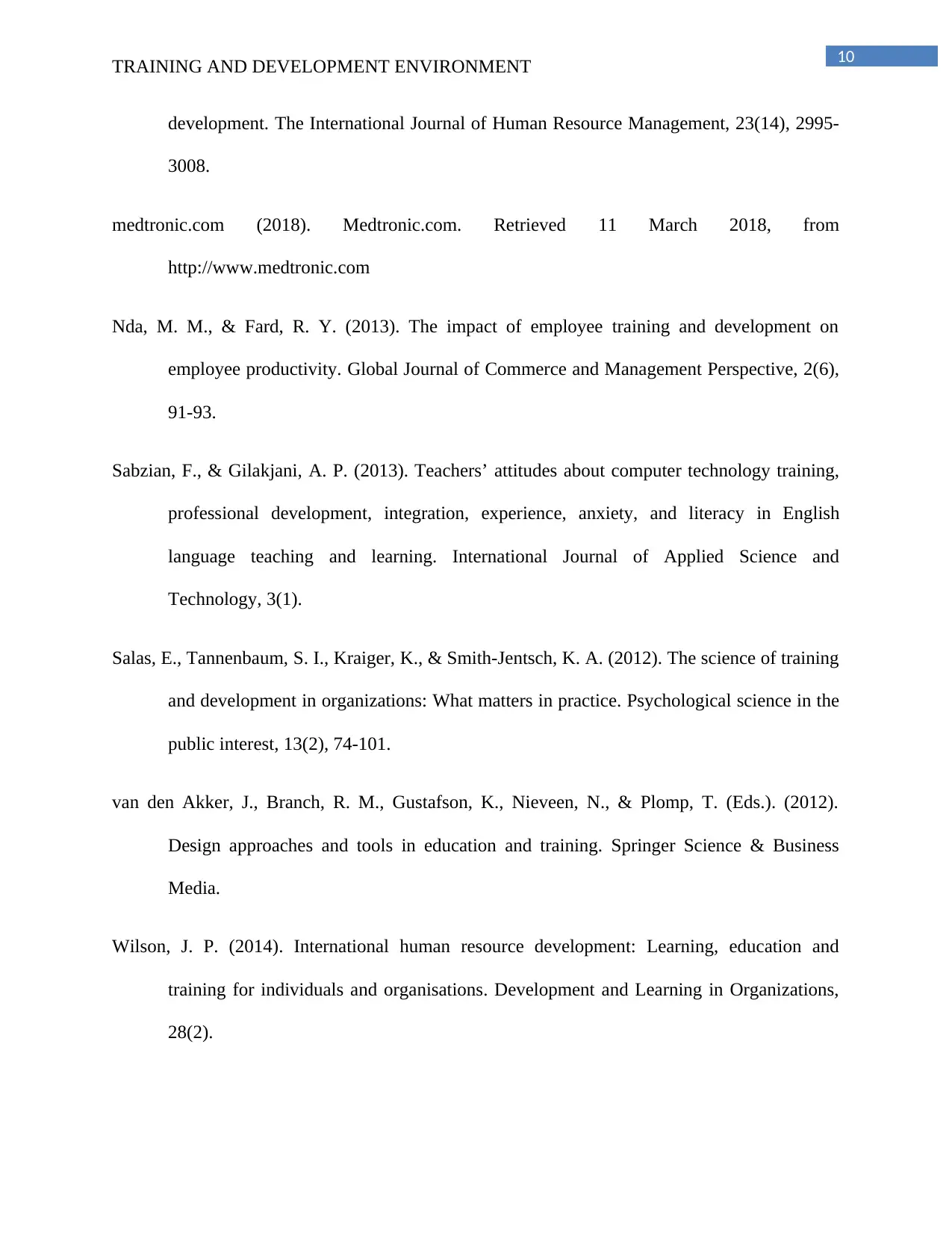
10
TRAINING AND DEVELOPMENT ENVIRONMENT
development. The International Journal of Human Resource Management, 23(14), 2995-
3008.
medtronic.com (2018). Medtronic.com. Retrieved 11 March 2018, from
http://www.medtronic.com
Nda, M. M., & Fard, R. Y. (2013). The impact of employee training and development on
employee productivity. Global Journal of Commerce and Management Perspective, 2(6),
91-93.
Sabzian, F., & Gilakjani, A. P. (2013). Teachers’ attitudes about computer technology training,
professional development, integration, experience, anxiety, and literacy in English
language teaching and learning. International Journal of Applied Science and
Technology, 3(1).
Salas, E., Tannenbaum, S. I., Kraiger, K., & Smith-Jentsch, K. A. (2012). The science of training
and development in organizations: What matters in practice. Psychological science in the
public interest, 13(2), 74-101.
van den Akker, J., Branch, R. M., Gustafson, K., Nieveen, N., & Plomp, T. (Eds.). (2012).
Design approaches and tools in education and training. Springer Science & Business
Media.
Wilson, J. P. (2014). International human resource development: Learning, education and
training for individuals and organisations. Development and Learning in Organizations,
28(2).
TRAINING AND DEVELOPMENT ENVIRONMENT
development. The International Journal of Human Resource Management, 23(14), 2995-
3008.
medtronic.com (2018). Medtronic.com. Retrieved 11 March 2018, from
http://www.medtronic.com
Nda, M. M., & Fard, R. Y. (2013). The impact of employee training and development on
employee productivity. Global Journal of Commerce and Management Perspective, 2(6),
91-93.
Sabzian, F., & Gilakjani, A. P. (2013). Teachers’ attitudes about computer technology training,
professional development, integration, experience, anxiety, and literacy in English
language teaching and learning. International Journal of Applied Science and
Technology, 3(1).
Salas, E., Tannenbaum, S. I., Kraiger, K., & Smith-Jentsch, K. A. (2012). The science of training
and development in organizations: What matters in practice. Psychological science in the
public interest, 13(2), 74-101.
van den Akker, J., Branch, R. M., Gustafson, K., Nieveen, N., & Plomp, T. (Eds.). (2012).
Design approaches and tools in education and training. Springer Science & Business
Media.
Wilson, J. P. (2014). International human resource development: Learning, education and
training for individuals and organisations. Development and Learning in Organizations,
28(2).
1 out of 11
Related Documents
Your All-in-One AI-Powered Toolkit for Academic Success.
+13062052269
info@desklib.com
Available 24*7 on WhatsApp / Email
![[object Object]](/_next/static/media/star-bottom.7253800d.svg)
Unlock your academic potential
Copyright © 2020–2025 A2Z Services. All Rights Reserved. Developed and managed by ZUCOL.




